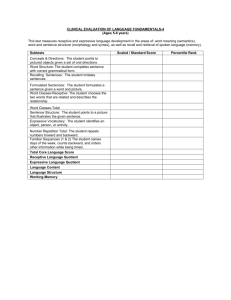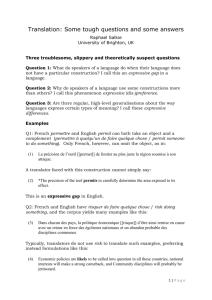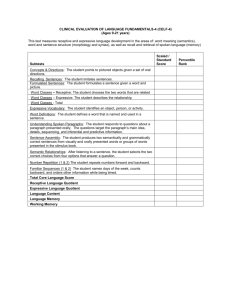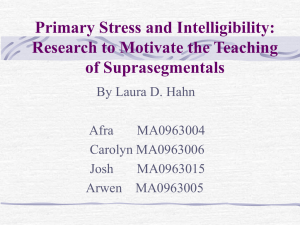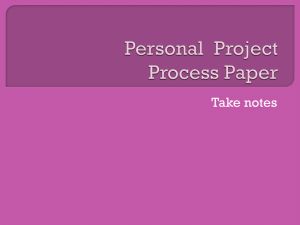Speech sound assessment
advertisement
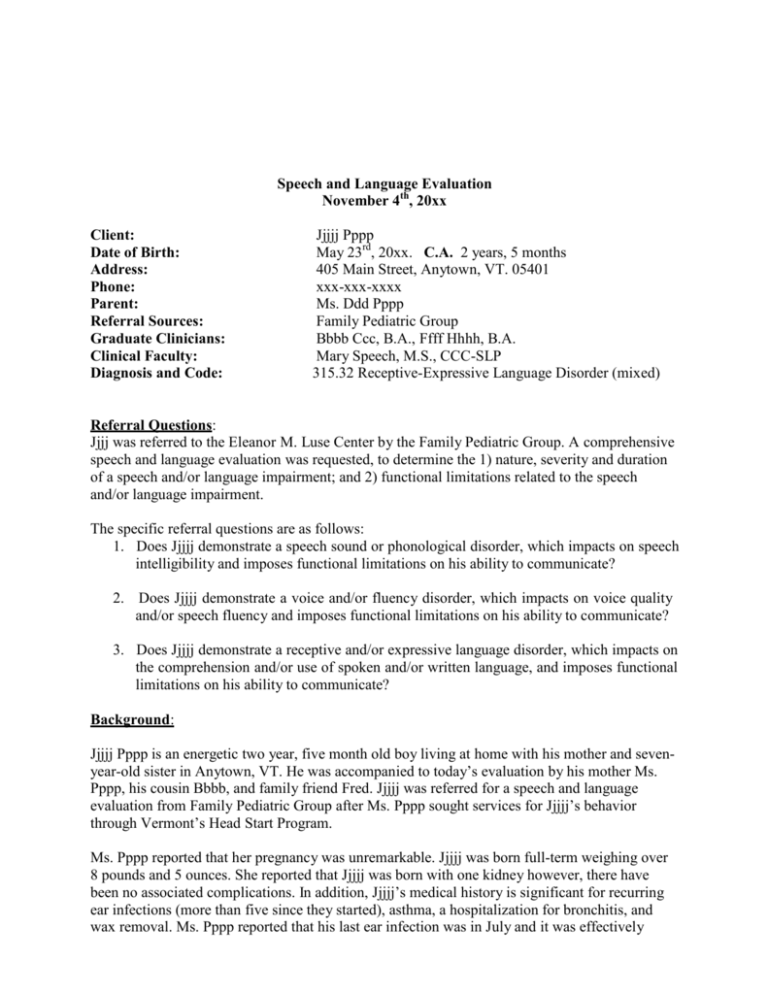
Speech and Language Evaluation November 4th, 20xx Client: Date of Birth: Address: Phone: Parent: Referral Sources: Graduate Clinicians: Clinical Faculty: Diagnosis and Code: Jjjjj Pppp May 23rd, 20xx. C.A. 2 years, 5 months 405 Main Street, Anytown, VT. 05401 xxx-xxx-xxxx Ms. Ddd Pppp Family Pediatric Group Bbbb Ccc, B.A., Ffff Hhhh, B.A. Mary Speech, M.S., CCC-SLP 315.32 Receptive-Expressive Language Disorder (mixed) Referral Questions: Jjjj was referred to the Eleanor M. Luse Center by the Family Pediatric Group. A comprehensive speech and language evaluation was requested, to determine the 1) nature, severity and duration of a speech and/or language impairment; and 2) functional limitations related to the speech and/or language impairment. The specific referral questions are as follows: 1. Does Jjjjj demonstrate a speech sound or phonological disorder, which impacts on speech intelligibility and imposes functional limitations on his ability to communicate? 2. Does Jjjjj demonstrate a voice and/or fluency disorder, which impacts on voice quality and/or speech fluency and imposes functional limitations on his ability to communicate? 3. Does Jjjjj demonstrate a receptive and/or expressive language disorder, which impacts on the comprehension and/or use of spoken and/or written language, and imposes functional limitations on his ability to communicate? Background: Jjjjj Pppp is an energetic two year, five month old boy living at home with his mother and sevenyear-old sister in Anytown, VT. He was accompanied to today’s evaluation by his mother Ms. Pppp, his cousin Bbbb, and family friend Fred. Jjjjj was referred for a speech and language evaluation from Family Pediatric Group after Ms. Pppp sought services for Jjjjj’s behavior through Vermont’s Head Start Program. Ms. Pppp reported that her pregnancy was unremarkable. Jjjjj was born full-term weighing over 8 pounds and 5 ounces. She reported that Jjjjj was born with one kidney however, there have been no associated complications. In addition, Jjjjj’s medical history is significant for recurring ear infections (more than five since they started), asthma, a hospitalization for bronchitis, and wax removal. Ms. Pppp reported that his last ear infection was in July and it was effectively treated with antibiotics. Ms. Pppp reported that Jjjjj does not take any medications but does use a nebulizer when he has a cold to help with wheezing. Ms. Pppp reported that Jjjjj said his first word at approximately one-year of age and that his vocabulary continues to grow. Jjjjj’s speech and language development was characterized by Ms. Pppp to have expanded significantly over the summer months. Some examples of words he uses at home are: mama, dad, Jojo, sissy, me, Jjjjj, no, pushup, crabby, and help. Ms. Pppp reported that Jjjjj understands everything that is said to him and is easily understood by others. It was reported that Jjjjj both vocalizes and uses gestures to make wants and needs known; however sometimes he uses his behavior more than words to express himself. Ms. Pppp, Bbb, and Fred characterized Jjjjj’s behavior as problematic and that it results in him kicking, hitting, and knocking things over. Ms. Pppp reported that these behaviors occur both when Jjjjj is told “no” and spontaneously throughout the day. She reported that his behavior is difficult to manage, as she does not know what is causing it. According to the pediatric case manager report from Visiting Nurse Association (VNA) of Monroe & Block Counties, there were concerns regarding Jjjjj’s family stability, familial isolation, and the cognitive/mental status of his primary caregiver. These environmental factors place a child at risk for a developmental language delay. Assessment: Formal and informal assessment measures were used in today’s evaluation to assess Jjjjj’s speech and language skills. Hearing Screening: Otoscopic visualization was conducted to assess tissue health, overall appearance of the ear canals and tympanic membranes (eardrums). The left tympanic membrane was partially visualized as the ear canal was partly occluded with wax. Both tympanic membranes were unremarkable for signs of infection. Tympanometry was conducted to assess ear canal volume, tympanic membrane compliance and middle ear pressure. Results indicated an ear canal volume within normal limits in both ears and compliance and middle ear pressure exceeding normal limits in the right ear. No compliance within the middle ear space of the left ear was obtained. Lack of compliance within the middle ear space is indicative of fluid behind the tympanic membrane. A pure-tone threshold hearing screening across all frequencies (250Hz, 500Hz, 1000Hz, 2000Hz, 3000Hz, 4000Hz, and 8000Hz) at 20dB was conducted using sound field testing and conditioned play audiometry. Jjjjj passed the hearing screening. Oral Speech Mechanism Screening Examination An examination of Jjjjj’s oral structures, speech motor function, and swallowing abilities was completed by parent report and observation during today’s evaluation. An attempt was made to examine function “on command”; however Jjjjj was shy and did not want to follow the directions. It was observed however that he performed several of these tasks spontaneously throughout the evaluation. Initial observation of Jjjjj’s facial structures revealed symmetry at rest. Jjjjj is characterized as a nose breather, which was apparent based on his closed mouth posture. He coughed intermittently [Type text] throughout the evaluation; however no signs of congestion were noted. Jjjjj was asked, on command, to open his mouth and stick out his tongue given verbal and visual cues from the clinician. Following several attempts by the clinician, Jjjjj opened his mouth for his mother where his oral structures were partially visualized. Adequate range of motion, normal smooth movement of the jaw, symmetry of lips and jaw in both open and closed mouth postures were observed. His dentition was not visualized; however, Ms. Pppp reported that he has all of his teeth. Jjjjj was asked on command to protrude his tongue. Jjjjj’s tongue surface color and size appeared normal, well hydrated, and symmetrical. During play activities with bubbles, Jjjjj spontaneously smiled, puckered lips, and puffed his cheeks. Symmetry of these structures, in both open and closed positions, was present and range of motion appeared adequate. Jjjjj’s hard and soft palate were not visualized; however, his voice quality and resonance appeared to be typical for a child his age. Neither signs of hyper nor hyponasality were noted. During a break in the evaluation, Jjjjj took a drink from the fountain and a water bottle. There was no observation of liquid escaping when Jjjjj was drinking, indicating good bilabial closure. Ms. Pppp reported that Jjjjj experiences no difficulty chewing and swallowing. Several components of the speech mechanism were assessed today through the spontaneity of speech functions. The strength of Jjjjj’s lips, tongue, and jaw appeared to be within normal limits. Visualization of the hard and soft palate, tonsils, faucial pillars, uvula, and oropharynx could not be assessed and therefore are not reported. Based on parental report and observations during today’s evaluation, Jjjjj’s oral structures and oral articulator function appeared to be adequate to support speech. Language Assessments The Preschool Language Scale – Fourth Edition (PLS-4) assesses both auditory comprehension and expressive communication for children between birth and 6 years, 11 months of age. This test is designed to examine a child’s level of language understanding as well as expressive communication strengths and difficulties. Jjjjj’s standard score of 102 for the Auditory Comprehension portion of this particular assessment is within the average standard score for his age group. The PLS-4 Auditory Comprehension component includes tasks that assess understanding spatial concepts, pronouns, and following two-step related commands in the absence of cues. Jjjjj was able to successfully complete all Auditory Comprehension Tasks within the PLS-4 for his age group of 24 to 29 months. The calculated standard score for Jjjjj’s Expressive Communication is slightly below the mean of his age group. Jjjjj’s standard score of 97 from the Expressive Communication component of the PLS-4 falls between 0 and -0.5 standard deviations of the mean standard score for individuals of Jjjjj’s age. Jjjjj demonstrated the ability to successfully name objects within photographs, request assistance, and to answer yes/no questions; all tasks within the 24 to 29-month age range for Expressive Communication. Jjjjj did not display the use consonant-vowel-consonant sound combinations in spontaneous speech or during clinician-elicited language activities. This expressive language ability falls within or below the language expectations of Jjjjj’s age group according to the PLS-4. Jjjjj’s Total Language Standard Score of 100, (a combination of his Auditory Comprehension and Expressive Communication abilities), is within the average range for his age group. According to the PLS-4, Jjjjj’s expressive and receptive language skills are considered typical for [Type text] his age and developmental level. Table 1 – Jjjjj’s Preschool Language Scale – Fourth Edition Results Norm-Referenced Scores Raw Standard SS Percentile Score Score Confidence Rank (SS) Band (at (PR) 95% level) 31 102 93 to 111 55 Auditory Comprehension 32 97 89 to 105 42 Expressive Communication 100 92 to 108 50 Total Language 63 Score PRs for SS Confidence Band Values 32 to 76 24 to 62 29 to 71 Throughout today’s evaluation, Jjjjj produced accurate productions or close approximations of fifty-five words. This finding is consistent with parental report regarding Jjjjj’s expressive vocabulary consisting of more than fifty words. The expressive vocabulary words verbalized by Jjjjj during today’s session are listed in Table 2. Table 2 – Jjjjj’s observed expressive vocabulary as of November 4, 2010 Expressive Vocabulary Nouns Pronouns Verbs Greetings and Valedictions Negation and Affirmation Yeah No Adverbs Here There Question Words What Articles The Adjectives Big Blue Green One Ready Right Two Prepositions At Up Jjjjj’s mean length of utterance (MLU) in morphemes was calculated based on a conversational speech sample obtained from the observation of parent-child interaction. The expected MLU for a child between the ages of two and three years is approximately 2-3 morphemes per utterance. Jjjjj displayed an MLU of 2.07 during spontaneous speech. [Type text] Sections of The Rossetti Infant-Toddler Language Scale were used to informally assess Jjjjj’s gestures, play, interaction-attachment, pragmatics, language comprehension, and language expression. These sections were analyzed to provide more information into Jjjjj’s overall language development. Information was gathered using parental report, observation, and elicitation during the assessment. Results of the Rosetti indicate that Jjjjj’s level of interaction-attachment (e.g., requests assistance from an adult) and pragmatics (e.g., uses words to protest) are age-appropriate. Both play and gesture sections were unable to be fully assessed, as there were limited opportunities to observe, elicit, and receive parental report during the evaluation; however, Jjjjj did demonstrate appropriate use of gestures (e.g., slaps palm in response to “give me five”) and play (e.g., chooses toys selectively). Jjjjj’s language comprehension was evaluated as age-appropriate, within the range of 21-30 months and each item (e.g., responds to simple questions, follows novel commands) was observed, elicited, or reported by the parent. Jjjjj’s language expression best fit within the appropriate age range; however, he did not receive full credit for using threeword phrases frequently or referring to self by pronoun consistently. According to the Rossetti, these skills are typically developed within the 24-27 month and 27-30 month range respectively. Table 3 lists the items observed, elicited, or reported during the evaluation. Table 3 - Sections from The Rossetti Infant-Toddler Language Scale Sections InteractionAttachment Pragmatics Gesture 15-18 - Plays away from familiar people - Requests assistance from an adult - Retreats to caregiver when an unfamiliar adult approaches - Points to, shows, or gives objects - Controls the behavior of self and others - Uses words to protest No items to evaluate at this age level Play Did not evaluate Language Comprehension Did not evaluate [Type text] Age in Months 21-24 24-27 No items to evaluate No items to evaluate at this age level at this age level 27-30 No items to evaluate at this age level No items to evaluate at this age level No items to evaluate at this age level No items to evaluate at this age level - Gestures to request action - Pretends to pour from a container - Wipes hands and face - Slaps palm in response to “give me five” - Performs many related activities during play - Chooses toys selectively - Uses most toys appropriately - Points to four action words in pictures - Recognizes family member names - Understands the No items to evaluate at this age level - Puts away toys on request - Attempts to repair broken toys - Stacks and assembles toys and objects - Chooses one object from a group of five upon verbal request - Follows novel commands - Follows a two-step Unable to assess – no peer present - Responds to simple questions - Identifies four objects by function - Understands location phrases Language Expression Did not evaluate related command - Understands new words rapidly concept of one - Understands size concepts - Uses two-word phrases frequently - Uses 50 different words - Uses new words regularly - Relates personal experiences - Uses three-word phrases occasionally - Refers to self by name - Uses early pronouns occasionally - Imitates two numbers or unrelated words upon request - Asks for assistance with personal needs - Uses action words - Uses a mean length of 1.5-2.0 morphemes per utterance - Names one color - Responds to greetings consistently - Uses negation - Uses two sentence types, (declaratives and interrogatives i.e. “No, this fit,” “Need help,” “Shoes go right here,” and “What this?”) - Uses a mean length of 2.0-2.5 morphemes per utterance Note. No items were evaluated at 18-21 Months Speech Assessment and Intelligibility Jjjjj and his mother engaged in play during this diagnostic evaluation. Clinicians gathered information regarding Jjjjj’s speech based on this parent-child interaction. Jjjjj’s speech is characterized by the consistent use of consonant-vowel (CV) and CVCV syllable productions. Two unfamiliar listeners rated the intelligibility level of Jjjjj’s conversational speech during parent-child play. His speech intelligibility was calculated to be 49.5% based on the analyses of an individual 100-word speech sample. The expected intelligibility of a child in Jjjjj’s age range (28-30 months) is 66-74% (Weiss, 1980). The Weiss intelligibility score guidelines are normed percentage values that have been agreed upon by Bernthal & Bankson (2004). Such guidelines are accepted criteria within the speech and language pathology profession and therefore comply with Vermont Department of Education guidelines for evaluating individuals between birth and three years of age. Jjjjj produced sixteen consonant sounds, ten singular vowels, and three diphthong vowel sounds throughout today’s evaluation. Jjjjj’s vowel and consonant repertoires along with examples from his speech are included within Tables 4 and 5 below. Table 4 – Consonant phonemes within Jjjjj’s expressive language repertoire Consonant Repertoire Consonant /b/ Example from Diagnostic Evaluation “bee” /d/ CV vocalization – approximation of “this” “feet” “go” /f/ /ɡ/ /ʤ/ /h/ [Type text] “Jojo” (name of family friend) “here” /j/ /k/ /m/ /n/ /p/ /s/ /st/ blend /ʃ/ /t/ /w/ “yeah” CV vocalization “mama” “no” “pick” “sit” CV vocalization “shoe” “toolbox” “we” Table 5 – Vowel phonemes within Jjjjj’s expressive language repertoire Vowel Repertoire Vowel /ʌ/ and /ǝ/ /i/ /ɪ/ /e/ /ɛ/ /ӕ/ Example from Diagnostic Evaluation CV vocalization “feet” “this” “yay” “there” “hat” /ɑ/ /o/ /ʊ/ /u/ /aɪ/ “mama” /aʊ/ “mouth” /oʊ/ CV vocalization “no” “put” “shoe” “right” Jjjjj displays a variety of phonological error patterns within his speech. The clinicians observed final consonant deletion, gliding of liquids, vocalization of liquids, and stopping throughout Jjjjj’s speech. Table 6 depicts the error patterns produced by Jjjjj as well as examples from this diagnostic evaluation. Table 6 – Phonological error patterns within Jjjjj’s verbal speech output Phonological Error Patterns Final Consonant Deletion [Type text] Target Final Consonant /k/ Target Word “pick” Target Production /pɪk/ Jjjjj’s Production [pi-] /ks/ “toolbox” /tulbɑks/ [tubɑ-] /p/ “up” /ʌp/ [ʌ-] /s/ “this” /ðɪs/ [dɪ-] /t/ Gliding “right” /raɪt/ [waɪ-] “hat” /hӕt/ [hӕ-] “feet” /fit/ [fi-] /z/ “shoes” /ʃuz/ [ʃu-] /l/ /r/ “help” “there” /hɛlp/ /ðɛr/ [hɛʊ] [dɛʊ] “right” /raɪt/ [waɪ] “eyeball” /aɪbɑl/ [aɪbo] “toolbox” /tulbɑks/ [tubɑ] “this” /ðɪs/ [dɪ] Omission of Liquids /l/ Stopping /ð/ Summary: Jjjjj Pppp is an engaging and energetic young boy who cooperated throughout the evaluation. Due to his chronological and developmental age, formal and informal assessment tools were used in today’s evaluation. Jjjjj’s hearing was screened as a result of recurring ear infections. Both tympanic membranes were partially visualized due to wax obstruction and no signs of infection were noted. The tympanogram obtained in his left ear is consistent with fluid in the middle ear space. Ms. Pppp was informed of our findings and encouraged to follow-up with his primary care physician to monitor his recurring ear infections. Jjjjj passed today’s hearing screening. The oral mechanism examination was attempted in the typical format as an “on command task”; however Jjjjj was shy and did not comply. His oral structures were observed spontaneously through play. Typical voice quality and resonance for a child his age was noted throughout the evaluation. Jjjjj’s oral structures appeared to be functioning normally to support speech. Jjjjj’s expressive and receptive language abilities, as evaluated by the Preschool Language Scale – Fourth Edition, fall within the expected range for children of his chronological and developmental age. His expressive communication abilities resulted in a slightly lower standard score as compared to his receptive language abilities. Jjjjj’s Auditory Comprehension score is at the 55th percentile rank and Expressive Communication at the 42nd percentile. With a 95% level of confidence, Jjjjj’s receptive and expressive language skills as well as his composite score of both Auditory Comprehension and Expressive Communication indicate that Jjjjj’s expressive and receptive language abilities are consistent with typically developing children of his age group according to the PLS-4. The Rossetti Infant-Toddler Language Scale was used to provide information of Jjjjj’s overall language development. Items were elicited, observed, or reported by Ms. Pppp. Levels of interaction-attachment, pragmatics, gestures, play, and language comprehension were all considered to be age-appropriate. The results from the language expression subtest of the Rosetti indicate that Jjjjj has met many but not all of the expressive language milestones often exhibited by children his age. Specifically, he did not use three-word phrases frequently nor consistently refer to himself using a pronoun. Jjjjj’s phonological error patterns contribute to a level of speech intelligibility that is below [Type text] average for his age group. Gliding, as a phonological error pattern, is considered developmentally appropriate for children up to 5 years, 5 months of age. Vocalization of liquids is appropriate for individuals of 4 years, 11 months and stopping is considered acceptable for children as old as 4 years, 5 months of age. Final consonant deletion, as a phonological pattern, is expected to cease prior to three years of age. The phonological error patterns observed are considered developmentally appropriate for a child of Jjjjj’s chronological age. Jjjjj’s speech intelligibility is below the level expected for his age group. Although the above mentioned phonological error patterns are age appropriate, their combination significantly affects Jjjjj’s overall intelligibility. The consistent consonant-vowel structure of Jjjjj’s utterances particularly reflects his pattern of final consonant deletion. The below average intelligibility rating (49.5% compared to age-expected 66-74% intelligibility rating) as judged by unfamiliar listeners has negative implications for success in educational settings as well as within one’s community. Without adequate speech and language stimulation, it is possible that Jjjjj may fall behind his same-age peers in terms of speech sound development, as his speech articulation has been judged as below average. Jjjjj presents with no indications of a fluency or voice disorder. Additionally, Jjjjj does not present with an expressive or receptive language disorder based on the information obtained during this evaluation. Comprehensive analyses of the The Rosetti Infant-Toddler Language Scale, Preschool Language Scale-Fourth Edition, and parent interview, in addition to informal observations indicate that Jjjjj’s auditory comprehension and expressive language skills are consistent with typically-developing individuals of his age. According to the Vermont Special Education Rules, a developmental delay is present when a child is demonstrating a 40% delay in skills (as measured by comparison of age equivalency on standardized tests and chronological age) or whose standardized score falls greater than two standard deviations below the mean on at least one measure. Based on the scores obtained in today’s evaluation, Jjjjj does not present with a developmental delay. His speech however is characterized by phonological processes such as final consonant deletion that contribute to an intelligibility score that is considered below average, as compared to peers of the same age (expected intelligibility range of 66-74%). Jjjjj’s intelligibility level of 49.5% negatively affects his ability to successfully communicate with unfamiliar listeners. Early speech intervention may remediate the existence of this developmental delay in communication. Recommendations: Based on the findings from today’s evaluation, the following items are recommended: 1. Parental training in the Hanen approach for increased communication opportunities is recommended to ensure continued speech and language development. 2. If the parents would like to pursue individualized speech therapy to work on increasing speech intelligibility through work on final consonant deletion, that therapy can be arranged at the Luse Center or alternative names of speech language pathologists can be provided. Therapy should be held at least two times per week for 20 minutes either in the home or in his day care. Prognosis: The prognosis for improved speech intelligibility is good based on parental interest and client willingness to learn skills to promote speech language effectiveness. [Type text] If there are any questions or concerns regarding this report or the information contained within it, please contact the Eleanor M. Luse Center at 656-3861. Bbbb Cccc, B.A. Graduate Clinician Mary Speech, M.S., CCC-SLP Speech-Language Pathologist Cc: Ms. Ddd Pppp 405 Main Street Anytown, VT 05401 Family Pediatric Group 155 Highway 10 Suite 22A Anytown, VT 05401 [Type text] Ffff Hhhh, B.A. Graduate Clinician
